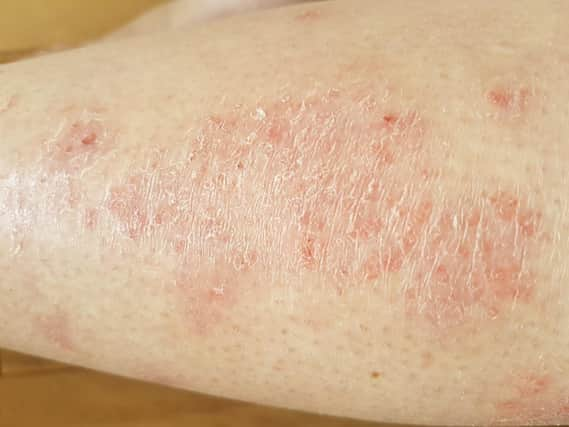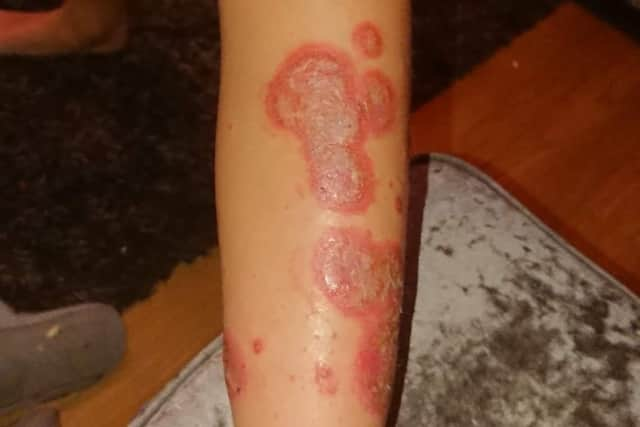What is psoriasis and how can it be treated


It is thought to affect between two per cent and three per cent of the population of the UK and Ireland.
Shelley Mair’s son Riley Hunt is 14, he was diagnosed with psoriasis at the age of ten alongside his sister who was six at the time.
Advertisement
Hide AdAdvertisement
Hide AdPsoriasis affects men and women equally and can occur at any point in the lifespan, affecting children, teenagers, adults and older people. However, there seem to be two peaks of onset: from late teens to early adulthood and between the ages of around 50 to 60.


It is a long-term condition that may wax and wane. Sometimes it can appear mild and other times it can be more severe.
Shelley, who lives in Angmering, said: “They had dry scaly patches on their skin and doctor referred us to dermatologist. To begin with it wasn't too bad but it got worse and he often had people at school ask what it was or make comments. He tried to not let it bother him but I could tell it did.”
Although there is no cure, psoriasis can be managed and, with the right treatment and advice, many people are able to live well with the condition.
Advertisement
Hide AdAdvertisement
Hide AdShelley’s son Riley underwent light therapy in March 2019 for one minute a week. She said: “It's like a stand up sunbed which uses UV light to help the skin heal. It helped massively and his skin cleared up after several sessions on light therapy. It does get bad again when the weather gets colder but recreation creams and sprays are good for when light treatment isn't required.


"He currently only has one patch on his leg now and definitely not as sore or red as it has been as we know how to treat it."
Patches of psoriasis, which are often called plaques, are raised red or dark patches of skin, covered with silvery white scales. These scales are the buildup of skin cells waiting to be shed and the redness is caused by the increase in blood vessels required to support the increase in cell production.
The plaques can appear in a variety of shapes and sizes, varying from very small to several centimeters in diameter. It has a well-defined edge, making it easy to tell where the psoriasis ends, and non-psoriatic skin begins. For some people, plaques may be thin or flat to the skin surface, but for others they may be much thicker. It is not unusual for psoriasis to be itchy, and it can often feel painful or sore.
Advertisement
Hide AdAdvertisement
Hide AdWhen a person has psoriasis, the skin replacement process speeds up, taking just a few days to replace skin cells that usually take 21 to 28 days. This results in an accumulation of cells on the surface of the skin, in the form of psoriatic plaques. This process is the same wherever it occurs on the body.
Usually, a trigger is required for psoriasis to develop, and this could be a throat infection, an injury to the skin, certain medications or physical or emotional stress. There are also others, as triggers can vary from one person to the next.
Emma Gould, from Hove, was diagnosed at the age of 16. It started in her scalp but was very mild, it wasn’t until the birth of her first child age 32 that it started spreading on her body and was diagnosed.
Psoriasis is much more than just a skin condition, however, affecting people physically and psychologically.
Advertisement
Hide AdAdvertisement
Hide AdEmma said: “The psychological aspects are so often missed. It made me hesitate before wearing short sleeved tops or shorts/skirts. I didn’t want to go swimming in public pools anymore as people used to stare and I didn’t want them to think it was contagious. It was on my mind all the time, every day.”
Emma first tried steroid creams but these eventually stopped working.
She said: “This is when I started to research natural healing methods. I found a book with a dietary and lifestyle plan in it and followed it completely for four and a half months.
"At first my skin got worse and worse but I stuck to it and eventually, after a lot of work, my skin completely cleared. This is what prompted me to retrain as a nutritional therapist so I could understand why my skin had cleared and so I could help others to do the same.”
Advertisement
Hide AdAdvertisement
Hide AdMost psoriasis treatment is under the guidance of a GP. It usually starts with treatments applied to the skin such as creams, ointments and gels with different active ingredients such as Vitamin D, steroids and coal tar preparations.
Moisturising regularly can be helpful with psoriasis as moisturisers and emollients help the skin feel more comfortable, and also help active topical treatments to be better absorbed and work more effectively.
If psoriasis is severe, or doesn’t respond adequately to topical treatments, a GP should provide a referral to a dermatologist, who can offer a further range of treatment options. These options include ultraviolet (UV) light therapy, which is given in a hospital setting under the supervision of a dermatologist or specialist nurse, as well as systemic and biologic treatments, which come in the form of tablets and injections.
Psoriasis is not contagious and cannot be transmitted from person to person through contact, or from one part of the body to another.
Advertisement
Hide AdAdvertisement
Hide AdFor more information and advice, visit www.psoriasis-association.org.uk